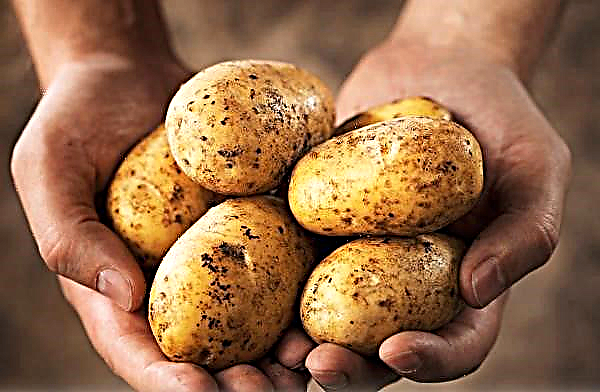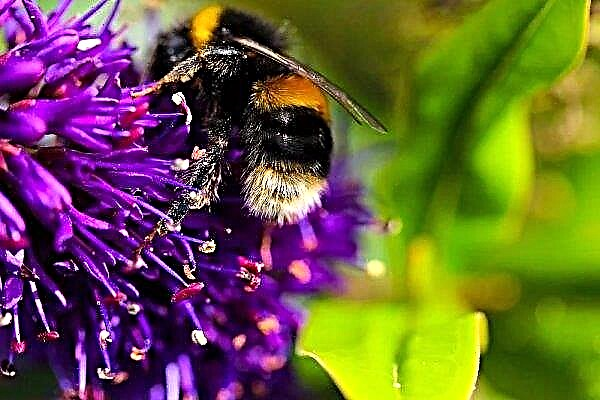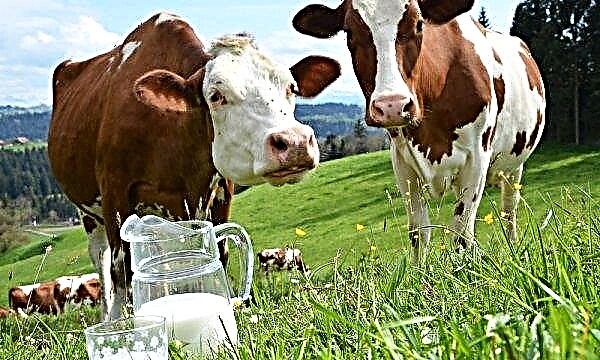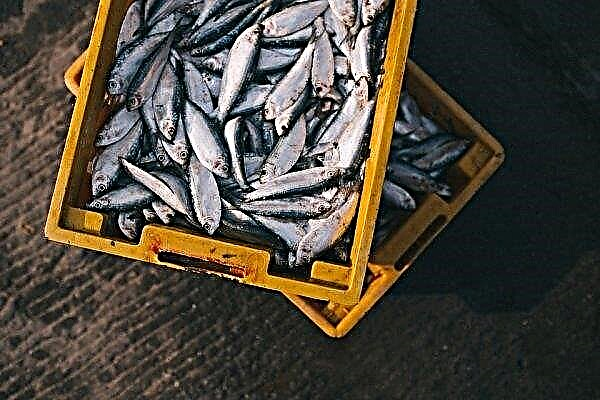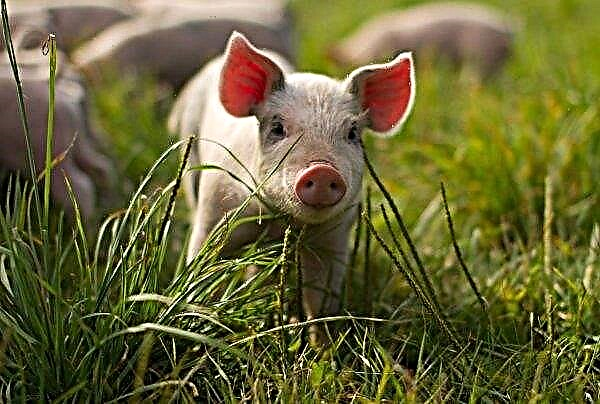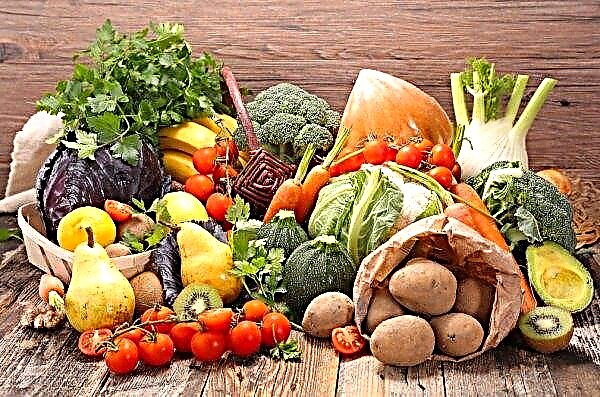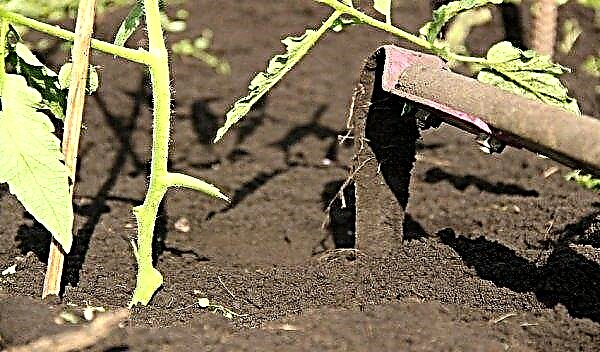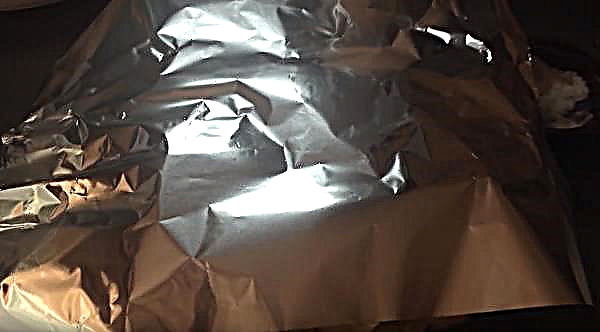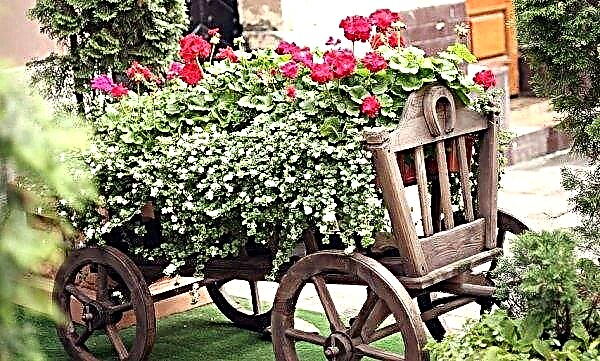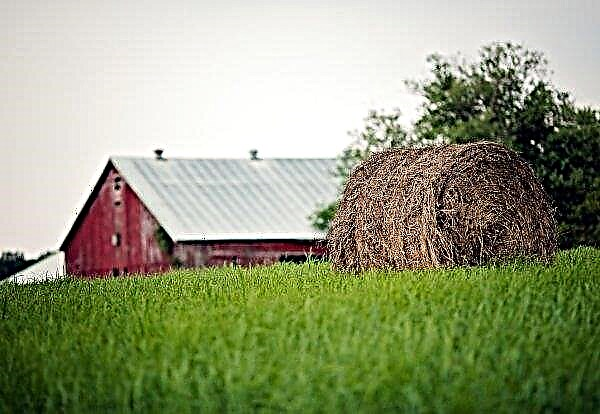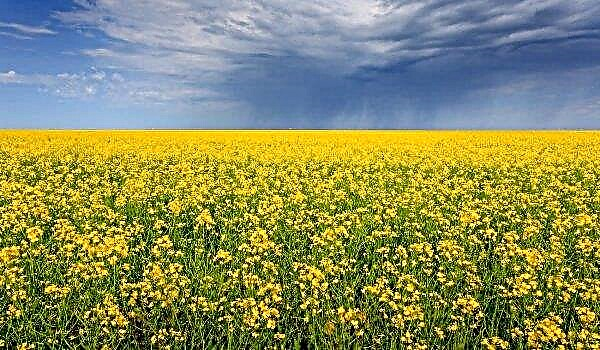A vegetable that has high taste and nutritional value, good yield and at the same time does not require much effort when growing, cannot be ignored by vegetable growers. And the winter sweet pumpkin also demonstrates excellent keeping quality, which allows it to be preserved from harvest to harvest. Read more about this pumpkin variety in the article below.
Description and characteristics of the variety
Winter sweet pumpkin ripens late, giving ripened pumpkins weighing from 8 to 12 kg 4.5 months after the germination of the first sprouts. It shows its best qualities in the climatic conditions of Moldova, Ukraine and in Russian regions with a similar climate.
Did you know? Pumpkins are grown for more than one thousand years everywhere on the planet. The only exception is Antarctica.
Externally, this pumpkin variety is characterized by:
- round pumpkin, flattened on top and bottom, with a segmented surface of a dark gray color, diluted with spots of light gray shades;
- large dark green leaves of a pentagonal shape;
- bushes of moderate weaving;
- dense but not thick skin;
- juicy compacted pulp of orange color;
- oval seeds of small size and yellow color with a hard shell.

Pros and cons of the variety
- The advantages of this pumpkin variety are associated with:
- high productivity;
- excellent gastronomic qualities;
- excellent keeping quality;
- good transportability;
- drought tolerance;
- resistance to most pumpkin diseases, especially to anthracnose and powdery mildew.
This variety does not have noticeable shortcomings. Sometimes in the northern regions in the cool and rainy summer there are problems with the sugar content of the fruit.
Planting and growing
Growing winter sweet pumpkin is not difficult and, following simple agricultural practices, is successful.
Important! You should not plant the pumpkin again in the same place earlier than after 4 years.
Soil and crop rotation requirements
This vegetable grows particularly well on neutral or slightly alkaline soils. With high soil acidity, it is reduced by making half a kilogram of dolomite flour or lime per square meter. m plot. Clay soil is made easier by adding peat to it.

It is best to grow pumpkin where previously grown:
- carrot;
- cabbage;
- potatoes;
- beans;
- peas;
- Tomatoes
- bow;
- garlic;
- clover.
Suitable conditions
This culture feels most comfortable in the temperature range from +22 to + 24 ° C. When the temperature drops to + 14 ° C, the development of lashes and the maturation of pumpkins are inhibited. For the fruit to ripen fruitfully and set their sugar content, the plant needs a lot of sunlight. Therefore, for the cultivation of these pumpkins, they choose sites well protected by the sun, protected from the winds.
Although the Winter Sweet pumpkin variety is drought tolerant, it develops best with a constantly moistened topsoil. However, during the ripening period, to increase the percentage of sugar in them, soil moisture should be reduced.
Check out other pumpkin varieties as well:
Soil and seed preparation
Being an annual plant, pumpkin propagates by seed. At the same time, in sweet varieties that are not hybrid, you can use seeds from the fruits of your own crop. With proper collection and storage, they do not lose germination up to 6 years.
Most often, prepared seeds are planted directly in the ground, but in regions with a cool climate they prefer to use the seedling method of growing plants. Before sowing seeds, the soil is prepared.
For each sq. m of the site are:
- humus - 2 buckets;
- sawdust - 0.5 buckets;
- nitrophoska - 1 glass;
- wood ash - a liter can.

Dig up the earth to a depth of at least 0.4 m and process it with hot water. Before sowing, the seeds are heated at a temperature of + 60 ° C for 3 hours. Then they are disinfected in a pink potassium permanganate solution.
To facilitate the emergence of the sprout from the hard shell, the seeds are soaked for half a day in infusion of wood ash or in cold water, replaced every 4 hours. Following the soaking, the seeds are directly planted in the ground or they are germinated. For this, a layer of sawdust treated with hot water is prepared at the bottom of the box.
Several layers of wet gauze are placed on top of the sawdust, on which seeds are placed, covered on top with a few more gauze layers. After falling asleep with wet sawdust, cover the box with glass or plastic wrap and leave it in this improvised greenhouse for a couple of days. During this time, the seeds germinate and become ready for planting in the ground.
Planting seeds
Seeds can be planted in open ground not earlier than when it warms up to + 10 ° С. A minimum area of 1x1 m is required for one pumpkin plant of the Winter Sweet variety. The seeds are buried in light friable soil by 0.08–0.1 m, in a denser soil by 0.05 m. Up to 5 seeds are placed in each hole with a small interval. After the appearance of the sprouts, the weakest of them are plucked off, leaving a couple of the strongest.
Care Features
Without requiring excessive efforts during self-care, the pumpkin nevertheless needs a competent approach when watering and feeding.
Watering and fertilizer
Even distinguished by drought tolerance, this pumpkin, having wide leaves with a large evaporating area, needs regular replenishment of moisture. After planting in the soil, the plant is watered with 1 liter of warm water, and then, as it develops, the amount of water is brought up to 10 liters per bush. 
In order to avoid the loss of sugar content as the pumpkins grow, the irrigation intensity is reduced, and when they reach the maximum size they are stopped altogether. During the period of an active set of green mass, the plant most of all needs organic fertilizers in the form of mullein, slurry or chicken droppings. Mullein is diluted in water in a ratio of 1: 8, slurry is diluted with water in a ratio of 1: 4, and chicken droppings are diluted with water in a ratio of 1:10.
It is useful to add 15 g of ammonium nitrate for every liter of organics. Buckets of the resulting fertilizer are enough for 6 bushes. During flowering, setting and fruit development, the plant already needs potassium and phosphorus to a greater extent. For this, superphosphate and potassium salt are most often used in the calculation of 20 g of each fertilizer per 1 liter of water.
Important! Since the pumpkin very quickly develops its root system, the roots of the sprouts are very intertwined. In order to avoid damage to the roots of the remaining germs, the removed plants should not be torn out, but should be plucked exclusively.
During the formation of pumpkins, wood ash saturated with:
- potassium;
- phosphorus;
- gray;
- calcium
- iron;
- magnesium
- boron;
- zinc
- molybdenum.
In this case, potassium and phosphorus, which are especially demanded by the pumpkin, are in the ash in a form readily available to the plant. For top dressing by introducing 100 g of ash under the root, the ash is diluted in a bucket of water, and for foliar top dressing, the amount of ash is halved with the same volume of water.
Soil cultivation and weeding
Weed weeding begins with the appearance of 5 leaves on the plant. Weeding is usually combined with loosening the soil around the bushes, which improves the oxygen supply to the root system. This is especially true after watering.  However, it is more advisable to loosen the row-spacings before irrigation for better soil moisture. During the season you have to weed the area with pumpkins up to 5 times. That is, until the pumpkin leaves completely cover the surface of the earth.
However, it is more advisable to loosen the row-spacings before irrigation for better soil moisture. During the season you have to weed the area with pumpkins up to 5 times. That is, until the pumpkin leaves completely cover the surface of the earth.
Bush formation
After seed germination and the appearance of sprouts, lateral shoots develop very quickly on them. Leaving the main and a pair of side, the rest must be removed. With the appearance of the ovaries, the excess should also be eliminated by leaving more than 3 on each lash. In addition, after counting 5 leaves following the extreme ovary on the lash, you need to pinch the rest of the lash. Then the plant will stop wasting energy on its development and focus on the supply of nutrients to the fruit.
Protection against diseases and pests
As mentioned above, the Winter Sweet pumpkin variety is quite resistant to many pumpkin diseases, however, violation of agricultural regulations and insufficiently comfortable growing conditions can lead to a weakening of the plant, which contributes to its disease:
- bacteriosiswhich is a bacterial disease that is combated through the destruction of affected plants, proper crop rotation and the preventive treatment of seeds with zinc sulfate (0.02%), as well as the plants themselves with copper chloride (0.4%) or Bordeaux liquid (1%);
- white rot, whose appearance is provoked by excessive humidity of air and soil, and they fight this fungal disease by spraying the leaves with a solution of 2 g of copper sulfate, 10 g of urea and 1 g of zinc sulfate, dissolved in a bucket of water;
- root rot, which is also a fungal disease that is prevented by pouring warm water, killing weeds and treated using the same treatment as in the case of white rot.

Of the pests the most dangerous are:
- spider mitesrepresenting a formidable danger, if you do not deal with them by spraying the leaves with ordinary water or, more efficiently, infusion of onion husks at the rate of 200 g per bucket of water or chloroethanol (20%);
- gourds, also able to bring the plant to death, if you do not fight weeds in a timely manner, do not follow crop rotation rules and do not spray lashes “Karbofos” (10%) or “Trifos” (10%).
Did you know? Pumpkins can be not only orange, but also gray, white, green and even blue.
The most effective preventative measures are:
- obligatory and competent crop rotation;
- rigorous removal of plant residues from the site;
- preventing the cultivation of other gourds next to pumpkins;
- selection of seeds only from healthy fruits;
- seed disinfection before sowing;
- regular weeding;
- timely removal of diseased plants;
- strengthening plant immunity with the help of competent fertilizing;
- regular inspection of landings in order to timely detect diseases and pests.
Harvest Dates
The main indicator of the readiness of the pumpkins for collection is their dark gray color without a splash of green and a dried stalk. The collected fruits for 2 weeks are kept fresh from the air under a canopy in warm and dry weather. After that, pumpkins are sent to the storage with a temperature ranging from +8 to + 14 ° С. The pulp of the pumpkin variety Winter Sweet is well suited for freezing.

If this is possible, the flesh is cut into cubes or ground on a grater and in sealed plastic bags sent to the freezer. Pumpkin can be stored in storage almost until a new crop. However, after 4 months, she has a decrease in sugar and a drop in carotene levels of 80%. Nevertheless, it retains its basic gastronomic qualities for a long time and almost in full.
Winter sweet pumpkin enjoys a deservedly good reputation among vegetable growers, as it is an almost ideal vegetable both in terms of taste and other consumer qualities, and in terms of its ease in the growing process.

